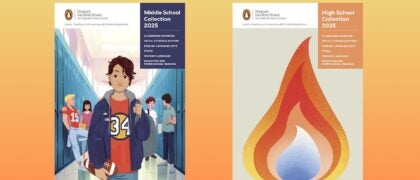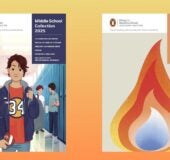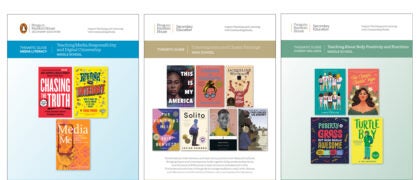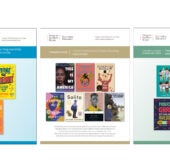Nhora Lucía Serrano is the associate director for digital learning and research at Hamilton College. Originally from Colombia, she is a medieval and early modern scholar whose areas of focus include Latin America and transatlantic studies, editorial cartoons and graphic arts, book history and print culture, and technology-enhanced learning and educational innovation. Serrano was a recipient of an NEH Summer Institute grant at the Newberry Library and a Smithsonian National Postal Museum and World Philatelic Exhibition Scholarship. She was a visiting scholar of comparative literature at Harvard University, a Mellon University Press Diversity Fellow at MIT Press / MIT, and a 2018 Eisner Industry Awards judge. She is a founding member and currently the Treasurer for the Comics Studies Society. She has served on the MLA Executive Forum GS Comics and Graphic Narratives (2014-2018), and presently serves on the MLA Executive Forum TM Book History, Print Cultures, Lexicography and is an elected MLA Delegate Assembly member. Serrano is the editor of Immigrants and Comics: Graphic Spaces of Remembrance, Transaction, and Mimesis (Routledge, 2021), co-editor of the Wilfrid Laurier University Press book series “Crossing Lines: Transcultural/Transnational Comics Studies,” co-editor of Curious Collectors, Collected Curiosities: An Interdisciplinary Study (2010), and her published essays have appeared in The Oxford Handbook of Comic Studies, MLA Approaches to Teaching Orhan Pamuk, MLA Approaches to Teaching Inca Garcilaso de la Vega, X-Tra Contemporary Art Quarterly, Museological Review, and other venues.
How did you get started reading comics?
I lived and spent my childhood in Milwaukee, Wisconsin. However, my parents and I are originally from Colombia, which means that I am an immigrant and a Latina who grew up in a Latin American cultural household in the Midwest where Spanish was the primary language spoken at home. As a young 5-year old niña in Milwaukee who loved art, museums, and drawing and painting at all hours of the day and night, I was quickly drawn to newspaper cartoons for their beautiful artwork and storytelling ability. My earliest recollections were of reading comics in the Sunday section of the Milwaukee Journal and in the Green sheet, the four-page section of the newspaper that was printed on green paper. In fact, since I did not yet read or understand spoken English, newspaper comic strips and cartoons like Ernie Bushmiller’s “Nancy,” Bil Keane’s “The Family Circus,” Hal Foster’s “Prince Valiant” and Charles M. Schulz’s “Peanuts” were my first foray into the American culture and the English language.
At that young age, my overwhelming fascination with pictures and art made it easy to read newspaper cartoons, and, thus, begin to decipher American humor and society. At that same time, however, I was also reading in Spanish: Quino’s “Mafalda” and Bushmiller’s “Periquita” (“Nancy” translated into Spanish). For me, the language of images was always transcultural and always came before my love for the written word.
How did you get from your first comics-reading experience to doing academic work in the medium?
My early childhood experience and excitement for reading images and cartoons returned when during my senior year of college I was enrolled in a French critical theory course with Prof. Marie-Hélène Huet. In this class we analyzed images and learned about their socio-political role in documenting and influencing society; in particular, I learned about mimesis and ekphrasis in literature, advertising, illustrations, and cartoons (e.g. Hal Foster’s “Prince Valiant,” Hergé’s “Tintin,” and René Goscinny and Albert Uderzo’s “Astérix le Gaulois”). This course not only introduced me to semiotics and cross-disciplinary work between art, history, politics, and literature, but it also showed me that visual culture studies was an academic field, one that spoke to me. It was an early watershed moment wherein I knew I wanted to immerse myself in all things dealing with pictures with/in words, and vice versa.
During graduate school, I naturally gravitated to a Comparative Literature department which permitted me to undertake a rigorous study of the world of illuminated manuscripts and illustrations. My dissertation focused on two unique illuminated manuscripts from the medieval and early modern time periods: (1) Alfonso X, el Sabio’s Las Cantigas de Santa María (códice F, Biblioteca Nazionale Centrale of Florence, circa 1280s), a Galician-Portuguese collection of poems, Marian miracles, and songs of praise with beautiful visual art laid out in a six to eight panel grids, and (2) Christine de Pizan’s Epistre Othéa in The Book of the Queen (Harley, 4431, British Library, circa 1410s), a mythological allegorical ‘letter’ in French with richly illuminated miniatures. In this early work, I began drawing comparisons between the socio-political milieu of book history and print culture with what it meant to editorialize society through images and text. Thus, as a trained visual culture studies scholar, I never veered far from the concept of the editorial cartoon.
Then, by happenstance in 2008, during my first academic job, my colleague Dr. Tim Caron and I won a year-long collaborative research and teaching grant which encouraged us to co-teach comics to undergraduate and graduate students and conduct our own research. It was during this time that I first taught comics from beginning to end in a university course, i.e. a course co-designed and devoted entirely to the study of the graphic narrative (cartoons, comic strips, comics, and graphic novels). In this year-long course, as well as subsequent courses I have taught on comics, I always start with an early unit on illuminated manuscripts. To this day, I read, teach, write, and research cartoons, comics, graffiti, and all printed ephemera through the lens of illuminated manuscripts, early illustrations, and material culture.
Have you seen a change in the academic and/or popular reception of comics and graphic novels over the course of your career?
In the past 20 years or so in the United States, there has been a notable and constant upsurge of a comics studies presence and acceptance within academia. For example, more universities and colleges are offering comics courses in their humanities and arts curricula (e.g. introductory surveys, advanced seminars, etc.) as well as approving comics-focused concentrations and dissertation-level study of comics. The University of Oregon’s extraordinary interdisciplinary program in comics and their “Comics and Cartoon Studies” minor is a great example of how comics studies is an academic discipline that engages in the “visual and linguistic systems of meaning” in the medium.
When it comes to academic scholarship, comics studies is today a very vibrant field as ever. Academic scholarly presses are publishing more books (i.e. monographs and edited collections) and many of them now have journals and books series on comics (e.g. European Comic Art, ImageTexT, Inks: The Journal of the Comics Studies Society, Palgrave Macmillan, Routledge: Taylor & Francis Group, Rutgers University Press, University of Mississippi Press, University of Texas Press, Wilfrid Laurier University Press, to name but a few). On a national scale, there are more papers on comics sprinkled throughout an academic conference program plus entire panels dedicated solely to the graphic narrative medium at conferences like the MLA and Popular Culture association (to name just two). Even on a more regional level, there are important conferences like Dartmouth College’s “Illustration, Comics and Animation” annual event (organized by Prof. Michael Chaney) and the MSU Comics Forum that bring together scholars and cartoonists. Also, I would be remiss to not mention two other exciting annual academic conferences for scholars at all stages and cartoonists, organized and sponsored by their non-profit organizations—International Comic Arts Forum (ICAF) and Comics Studies Society (CSS).
This being said, there is still so much work to be done in the areas of inclusivity and accessibility as well as the shaping of an inclusive comics studies canon, especially when it comes to global comics and diverse representation of cartoonists and scholars. While we do have more BIPOC, women, and queer scholars and students working in comics studies, we still need more representation in the field. Also, there needs to be more concentrated focus on understudied graphic narratives and overlooked and forgotten cartoonists as well as varied approaches. Yes, there is much archival work and research left to do in shaping a comics canon for the 21st Century. More importantly, it is urgent that the comics field worldwide commits to creating spaces for these rich discussion and debates, diverse scholarly work, and for cartoonists from all sections of society to create and present. It is an exciting time as the field is undergoing what I think is a ‘comics turn’ (similar to W.J.T. Mitchell’s 1990s claim of a “Pictorial Turn”), where spectacle, surveillance, image-making are at the forefronts of these productions, debates, and discussions. I am continuously inspired by my colleagues, younger scholars, graduate students, and today’s cartoonists worldwide who are leading the charge for more inclusivity on social media platforms like Twitter and Instagram, and through wonderful festivals in the U.S. like “Sõl-Con: The Brown, Black, & Indigenous Comix Expo (organized by Frederick Luis Aldama), “CXC: Cartoon Crossroads Columbus: A Comics, Art, & Animation Festival,” “Latino Comics Expo Worldwide,” and “The Latinx Comics Arts Festival” (to name just a few).
You’ve been an Eisner judge! And you’re the treasurer of the Comics Studies Society. Can you tell us about your work in these spaces?
What a sincere honor, thrill, and privilege it was to have served as a judge for the 2018 Will Eisner Comics Industry Awards. Jackie Estrada and my fellow judges—Candice (Wing-Yee) Mack, Graeme McMillan, Tate Ottati, Alex Simmons, and William F. Wilson—are phenomenal people with whom I am so lucky to have shared this once in a lifetime experience. Being an Eisner judge was exhilarating because it granted me permission to read comics nonstop from around the world for the year. In creating an eclectic and rich ballot, my fellow judges and I discussed in advance, and throughout the year, the extraordinary writing, drawing, inking, penciling, and coloring done in 2017. Then, we met in person over a very, very long weekend to finalize the ballot, which reflected the array of incredible and enriching diverse voices, characters, and stories that 2017 gifted to us all. Personal favorites of mine from that year include Marcelo D’Salete’s Run for It: Stories of Slave Who Fought for the Freedom, Taneka Stotts’ edited anthology Elements: Fire – A Comic Anthology by Creators of Color!, Emil Ferris’s My Favorite Thing is Monsters, Marjorie Liu and Sana Takeda’s Monstress, Santiago García and Javier Olivares’s The Ladies-in-Waiting, James F. Wright and Josh Eckert’s Contact High, Dale Carpenter and Nate Powell’s Awaiting a Wave, and Jake Halpern and Michael Sloan’s Welcome to the New World.
Many of us met up again later in the year at the Comic-Con awards banquet in San Diego to see firsthand the awards being handed out to the winners including witnessing Karen Berger being inducted into the Hall of Fame (what a treat!). On a personal level, another highlight of this experience was the opportunity to attend San Diego Comic-Con with my nephew Max Serrano-Wu and introduce him to the world of comics.
My work as the elected Executive Treasurer for the Comics Studies Society (CSS) has equally been a labor of love for the field of comics studies. In my role, I actively participate in board meetings as well as pay bills, present budget reports, maintain accounts, and coordinate the filing of taxes—all fun and traditional tasks tied to a treasurer position. All in all, the CSS Executive Board, which includes the CSS Graduate Student Caucus (GSC), supports and fosters professional development for its members through an annual conference, a professional journal called INKS, and network opportunities for scholars at all stages to share their ideas and meet. In particular, the CSS Executive Board and GSC together provide professionalization opportunities for graduate students and junior faculty members, i.e. mentoring program, travel grants for graduate students, contingent faculty, and female-identified or non-binary emerging scholar to the annual CSS conference. With the recent creation of an Ombudsperson for the organization, CSS is committed to fostering a welcoming and inclusive space for all our members. My term comes to an end this year, and it has been honor of my life to have participated in the early years of this organization.
You’ve done work about editorial cartoons throughout your career. What drew you to them?
My lifelong interest in editorial cartoons, or the political cartoon, has been about their humorous and satirical storytelling quality and their ability to deliver a socio-political jab within the graphic space. I am in constant awe how a single panel (or even a few sequential panels) can effectively and efficiently recount, convey, and critique multifaceted political and social real-life issues to the reader in print material (a newspaper or a magazine), digital format (web comics), or on a wall (graffiti). In particular, in the past years, I have returned to my graduate studies topic with how female personifications of political ideals or classical concepts are depicted as the storytellers in editorial cartoons—they are the guides who deliver the satire and critique directly to the reader. My recent interest has been keenly focused on the figures of Columbia (New Latin toponym for the United States and historical name for the Americas), Pan-America (supposedly representing all people of the Americas), and the Statue of Liberty, and how their race, gender, and ethnicity are represented and/or erased. For example, Columbia’s name is derived from the Italian explorer Christopher Columbus, not the land itself. Yet she and Pan-America (her counterpart and political twin) represent the so-called New World and often speak on behalf of those who are disenfranchised. In looking at early 20th century political cartoons, I have been asking myself what is her role precisely? Who is she? Where are her indigenous origins? For whom does she really speak? And how? And why do Columbia and Pan-America both disappear and mostly fade into obscurity from the editorial cartoon landscape in the mid-twentieth century? These lines of inquiry truly fascinate me. I enjoy bringing these questions into my teaching especially when I introduce students to female cartoonists like Ruby Lindsay Dyson, Nell Brinkley, Rose O’Neill, Anne Mergen, Ramona Fradon, Ethel Hays, Jackie Ormes, Trina Robbins, Ann Telnaes, Signe Wilkinson, Maitena Burundarena, Adene, Noelle Stevenson, Elizabeth Montague, Afua Richardson, Beth LaPensée, Ebony Flowers, MariNaomi, Jillian Tamaki, Whit Taylor, Jules Rivera (to name a few) who have all been trailblazers in their own rights for the cartoon form.
You just published your edited collection “Immigrants and Comics: Graphic Spaces of Remembrance, Transaction, and Mimesis” (Routledge 2021). What drew you to this topic?
As a daughter of immigrants, and an immigrant myself, this edited collection was a very personal project. Immigrants and Comics is part of the Routledge Advances in Comics Studies, and puts the spotlight on how comics are an integral part of the political and societal debates on immigration and citizenship, and how nations define themselves. This collection offers an opportunity to open the discussion on how a comics canon is made and what is included and excluded in such a canon that pertains to immigration. Equally, Immigrants and Comics provides an opportunity to examine how comics have played a crucial role in representing, constructing, and reifying the immigrant subject and the immigrant experience in the twentieth and twenty-first centuries. My recommendation to the reader is to keep in mind that it is in the aftermath of the 2016 U.S. presidential election and in anticipation of the 2020 U.S. presidential election, that this collection should be read and absorbed. It also stands holistically as an examination of how comics from around the world were shaped by the immigrant story, and how they inscribe the immigrant identity and experience by revealing what lies beneath through the critical shadows of visual history—the graphic narrative that enforces its own preservation.
Favorite or new graphic novel recommendations?
For editorial cartoons, I enjoy following, and highly recommend, a few twitter feeds: David Rowe (@roweafr), Afua Richardson (@AfuaRichardson), Keith Knight (@KeefKnight), Signe Wilkinson (@SigneWilk), Lalo Alcaraz (@laloalcaraz), Ann Telnaes (@AnnTelnaes), The Nib (@thenib), Adene (@Adenecartoon), Liz Montague (@lizatlarge), and Editorial & Political Cartoons (@EandPCartoons).
Presently, I am working on projects pertaining to the art world and museums in comics that have me immersed in a few personal favorites of mine: (1) Gus Arriola’s Gordo comic strip, (2) Jacques Tardi’s Adélè Blanc-Sec series, (3) Santiago García and Javier Olivares’s The Ladies-in-Waiting, and (4) Caitlin Cass’s work on suffragettes.
Most recently, I discovered and am intrigued by issue #1 of “The Picture of Everything Else” by Dan Watters, Kishore Mohan, and Aditya Bidikar.
Lastly, I highly recommend looking at any of the works by cartoonists I have mentioned in this interview, including works by John Jennings (twitter: @JIJennings), and the recent 2020 Guantanamo Voices: True Accounts from the World’s Most Infamous Prison edited by Sarah Mirk and visualized by a diverse group of artists. Happy reading! ¡Disfruta leyendo!
SOCIAL MEDIA
Twitter: @exnihilo13
Website: https://www.hamilton.edu/offices/lits/research-instructional-design/team-members/serrano





